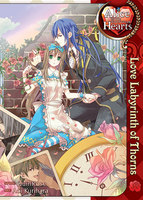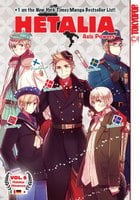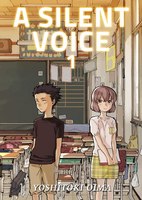RIGHT TURN ONLY!!
Mambo No. 6
by Rebecca Silverman,

And lo, the sun shone and the plants bloomed, and there were allergies! Luckily my personal nemesis, maple pollen, is about done, but my poor sister and two of the cats...Tucker has constant respiratory issues due to severe abuse as a kitten, but this time of year just makes it even worse – you can always tell where he is by listening for the snuffle. Horus, on the other hand, just gets puffy pink eyes, which makes him grumpy, which makes him pick on the other animals. My sister gets a combination of all three – the puff, the snuffle, and the grumpy. It's a joyous time of year in the Silverman home...let's talk about some manga to make things better!
 NO. 6
NO. 6
Vol. 6
(by Atsuko Asano and Hinoki Kino, Kodansha, $10.99)
FROM THE BACK COVER:
TO OBLITERATE NO. 6… THAT'S WHY I'VE COME.
A series of strange incidents cast a pall over No. 6 as it prepares to celebrate its "Holy Day." Meanwhile, in the tunnels beneath the Correctional Facility, Shion and Rat meet with the mysterious "Elder," who reveals the perverse origins of No. 6, and their connection to Rat's past. How will Rat react when Shion begins to touch his most secret scars?
REVIEW:
Distopias always start out with good intentions. Now as Shion hears the story of No. 6's origins as a city, he learns first hand about how base human greed can turn the utopia into something horrible and twisted, and he has to struggle not to let the same thing happen to him. Shion is definitely getting harder and less innocent as the story progresses, and it's interesting to note that these changes come from his attachment to Rat. Is there a parallel between how his love makes him darker and the ultimate fate of his home city? There's a sense that this might be the case, and that he might have to give something major up in order to achieve any sort of success – that's what everyone around him seems to have done, whether it was a conscious decision or not. The revelation of Rat's origins and the slow breakthrough of Dogkeeper's softer emotions make an interesting background to Shion's changes, and with Elder adding his story to No. 6's history, we have to really start wondering just what it was that Shion's mother Karan did back in the day. It's also worth considering that it is becoming increasingly obvious that No. 6 really is a very young city – could its corruption have been part of the plan all along?
Hinoki Kino continues to do a fine job of adapting the novels into manga format, and for those who have seen the anime, there is a lot more information to be had here. Kino includes cut scenes at the end of the volume this time as well, giving us even more source material. The desolation of the Correctional Facility and the West District and the Barbie's Dream House perfection of No. 6 itself come across clearly, and if Shion's facial expression is often set at “slightly stunned,” it can be forgiven because everything else is well done.
RECOMMENDATION: Buy it. No. 6 is more romantic and gritty in its manga form than the anime was, and the extra details make this tough to put down even if you know the story. And if you don't already know where this is headed, it's even more exciting – distopian science fiction that doesn't disappoint.

SWEET REIN
Vol. 2
(by Sakura Tsukuba, Viz, $9.99)
FROM THE BACK COVER:
Sad at the thought of spending Christmas alone, Kurumi Sagara goes out for a walk. While she's crossing the street, a boy bumps into her, and a rein suddenly appears that binds them together. The overjoyed boy tells her she's his master and that she's a Santa Claus. Kurumi dismisses him as a crazy person, but then he transforms into a reindeer?!
Kurumi and Kaito have remained together for a year, but a Dark Santa appears, intent on breaking the two apart. Kurumi and Kaito's rein is severed, and the Dark Santa takes control of Kaito. Can Kurumi manage to get Kaito back, even when she's still unsure if he's truly happy as her servant?
REVIEW:
One thing you can absolutely say about Sakura Tsukuba – very few authors can beat her at the sweet and charming game. While this second volume of her Santa story doesn't do a whole lot to expand on either of the main characters or to really advance the story, it remains heartwarming as concerns Kurumi and Kaito. It's too bad that we don't see any real progression in their relationship, but the second chapter, which deals with the “dark Santa” who tests their devotion to each other – in other words, that Kurumi isn't trapping Kaito in an abusive relationship – clearly shows that whatever feelings they have are mutual. Interestingly enough, Tsukuba seems a little more leery of her own base concept in this volume, with Kaito's brother Rihito finding his Santa. Rihito is not happy about this development, and he's very clear with his (male) Santa that this is not a situation that he's especially comfortable with. There are lingering hints of a cute bromance between the two, but it's still very much the less good side of the Santa/reindeer situation Tsukuba has developed. The weakest part of the book is probably the short story in the back - “The Door to Eden.” It's a silly story about a boys' school and a girls' school separated by a wall and the boys who want to cross it. There's a little cross dressing and a little goofiness, but overall it just isn't up to Tsukuba's usual level. She knows it too – all of her commentary is about how she's not pleased with the way it came out.
RECOMMENDATION: Borrow it from a friend or a library. I love Tsukuba's work, but this one just doesn't flow as well as the others and “The Door to Eden” simply isn't very good. In the interest of full disclosure, however, it may be worth considering that I'm not a big fan of Christmas-themed stuff, so if you love that theme in general, you'll probably want to buy this.

ANIMAL LAND
Vol. 9
(by Makoto Raiku, Kodansha, $10.99)
FROM THE BACK COVER:
With the fate of the entire animal kingdom at stake, Taroza and his friends tackle the dreaded Tower of Babel and its cohort of monstrous chimera guardians. They were prepared for a fight, but were they expecting to see... humans? The tragic past behind the tower's purpose is brought to light, and Taroza's leadership ability is tested when he must choose between the greater goal and the lives of his friends...
REVIEW:
Makoto Raiku's Animal Land has always had an edge of danger and sadness, but with the major death in the beginning of volume eight, followed by the time skip, the story has moved firmly into life-or-death territory, revealing itself for the dystopia it is. This volume continues that trend, upping the disturbing factor significantly once Taroza and his animal friends enter the Tower of Babel. We already suspected, if not knew, from earlier volumes that the tower was the last place humanity lived before it's extinction and Quo's transportation of the five Miracle Children to the future, but seeing it...that's a whole different story. To say that the scenes built around (our) modern-day Tokyo get disturbing fast is to understate the situation – if the Mask of the Flesh in Inu Yasha creeped you out, prepare to have nightmares.
While Giller, Capri, Taroza, and Riemu do all have big parts to play – Capri least of all – the biggest moments belong to the animals. Catherine the hippo's scenes carry the most emotional weight, and there are definitely some tear-jerker moments here. That's why it's too bad that Taroza's sister Moko is really just an accessory and that we don't see more of his inner turmoil – or Capri's for that matter. She's clearly going through some tough emotional times, feeling torn between her pride and the humans, and Giller is just as clearly not a good guy to be working for. And whatever happened to Jyu? Things seem to be moving faster than Raiku can get them down on paper, which leaves things feeling a little underdeveloped.
RECOMMENDATION: Borrow it from a friend or the library. I'm really torn on this, actually – Animal Land is a fascinating series, and when it resolves, it may prove worth owning for re-reads. But it's also the series I keep forgetting about until I notice that three volumes have piled up, which is why it ultimately gets a “borrow.”

ALICE IN THE COUNTRY OF HEARTS: LOVE LABYRINTH OF THORNS
Single Volume
(by QuinRose and Aoi Kurihara, Seven Seas, $13.99)
FROM THE BACK COVER:
Explore the stormy romance between Alice and the grim Clockmaker!
Unwillingly drawn into the Country of Hearts, Alice decides to make the Clocktower her home. However, the volatile relationship between Alice and Julius the Clockmaker does not make her stay easy. Just when she thinks she's had enough, other players who vie for Alice's heart enter the picture: the dream demon Nightmare, and the dashing Ace of Hearts. Who will Alice choose?
REVIEW:
The best part about an Alice storyline featuring Julius is that it is sweet and nearly entirely devoid of strange creepiness. The downside? This is kind of like a cheesier version of the previous Clockmaker manga, something that is perhaps due to the fact that they both take place during Alice in the Country of Hearts. There are really three major differences between Love Labyrinth of Thorns and its predecessor: a damsel-in-distress plot twist, a new artist, and no sex, even implied. The middle point there is perhaps the most noteworthy, as Aoi Kurihara makes Alice much cuter than she is in most other incarnations, almost doll-like in some shots. While this doesn't feel like it fits with Alice's personality, it is a nice change from franchise regular Mamenosuke Fujimaru. The men look rather younger in Kurihara's hands, and that really works for Ace, who, along with Nightmare, play the catalyst roles for Alice and Julius' romance. Nightmare is the one who orchestrates the obviously “Sleeping Beauty” inspired damsel moment, and while it is kind of corny and puts Alice in a less proactive position, it is also a change, and at this point with the sheer amount of Alice books out (and coming!), that's really a good thing. As an interesting note, Kurihara mentions in her afterward (another rarity for the franchise) that she got to write this because she won a contest. Is that how all of the artists are chosen?
RECOMMENDATION: Borrow it from a friend or a library. It's good, but it really isn't different enough to recommend buying it. This of course is unless you are a Julius fan, in which case you'll probably want it on your shelves.

HETALIA
Vol. 6
(by Hidekaz Himaruya, TokyoPop/RightStuf, $13.99)
FROM THE BACK COVER:
Estonia wants to make the Baltic Three a Baltic Duo, the micronations search far and wide for new friends, and Seychelles gets a mysterious visitor from the African mainland! Then the cats of Nekotalia return!
REVIEW:
Hidekaz Himaruya may have left any semblance of chronological order behind a long time ago, but Hetalia continues to be a fun look at world history and international relations. This volume largely leaves WWII out of it, and there's only a little bit of Chibitalia. The main focus of the book is divided in two – the Baltic/Northern European states and Seychelles. The latter is a bit better, partially because for many North American readers, Seychelles isn't really on the common awareness map, but also we can tell who she is by looking at her. With all of the Northern European countries, that's a bit trickier, particularly Finland and Iceland. Prussia and Germany also get their time in the spotlight, and there are some good jokes about England not raising America right, as well as a nice spotlight on Canada. Sealand and his fellow micronations also get to shine (England didn't raise him right, either), and generally speaking this is a light bit of fun. Nekotalia really doesn't do a whole lot, and would probably have been more interesting if it had focused on specific breeds from specific nations, and the hopping around through time can get a bit confusing. Overall, however, this is still a whole lot of fun, and watching Himaruya continually expand his characters is always interesting. An essay in the back gives some Prussian history (and explains why Germany is the younger brother), and color pages in the early printings are pretty great.
RECOMMENDATION: I'm hesitant to say borrow it, simply because I'm not sure how easy that would be, but that's basically how I feel about this volume. Hetalia's still fun, but it's not quite as good as when it was a little more focused. I do love Seychelles, though...

A SILENT VOICE
Vols. 1 & 2
(by Yoshitoki Oima, Crunchyroll, premium membership)
FROM CRUNCHYROLL:
I wish we had never met. I wish we could meet once again. A boy who can hear, Shoya Ishida, and a transfer student who can't, Shoko Nishimiya. One fateful day, the two meet, and Shoya leads the class in bullying Shoko. But before long, the class shifts its target from Shoko to Shoya. Years later, Shoya feels strongly that he must see Shoko once again. Written under the supervision of the Japanese Federation of the Deaf.
REVIEW:
Kids can be cruel. That's a fact that most of us are aware of, but not a lot of manga (in English) bothers to really look at the consequences of that cruelty, or even at children with special needs. A Silent Voice covers both topics, and in its first two volumes, it does it really well. Shoya begins the story as a casually cruel sixth grader, all about bravado and swagger, driven by his older sister's issues with boredom to combat life. Everything changes when a new girl transfers into his class. Her name is Shoko and she's Deaf. No one in school speaks sign language and despite Shoko's eagerness to make friends, Shoya leads the class in bullying her...until it all turns around on him. Suddenly Shoya becomes the victim, and when Shoko's mother transfers her to another school, he is left alone. Years later he's a senior in high school planning to commit suicide. Shoya's guilt at what he did to Shoko and years of being told that he's a worthless piece of trash have lead him to believe that the best thing he can do is die. When he meets Shoko again, however, things begin to turn around, and he starts to realize that life may be worth living after all.
A Silent Voice is a very powerful story about being different and the consequences of childhood bullying. Shoya does his best to atone, learning sign language on his own without telling anyone, and the emotional beating that he's taken has really almost destroyed him. As someone who was bullied myself – I remember one incident where I was cornered in a bathroom and had my glasses flushed down the toilet – it is at times difficult to read about him as a former bully, but at the same time he is sympathetic for what he himself then went through. Oima's art isn't spectacular, but it works very well, and some of his imagery, like Shoya seeing everyone with big x's over their faces, is quite powerful. To say that this is a difficult story would be accurate; it is also one that is very much worth reading. Hopefully it gets a print edition in the future, because it really deserves more exposure.
RECOMMENDATION: Read it. Really, this title alone is worth the Crunchyroll subscription.

AFTER SCHOOL ADVENTURE VALIANT
5 volumes
(by Takeshi Takebayashi, price and publisher vary by country)
FROM THE ITALIAN PUBLISHER:
Daiki Okuma is trying to confess his love to the beautiful Mami Fukuzawa when he witnesses a dimensional portal opening. A girl and a monster come out of it, and Mami is injured during their battle. Daiki is then informed by the girl, whose name is Selphy, that he's the only way to save Mami is to take her to the world on the other side of the portal...
REVIEW:
Known in the U.S., albeit not widely, for his ecchi series Time Traveler Ai and Maxion, both published by CPM in huge, flipped editions, Takeshi Takebayashi's After School Adventure Valiant is actually his most enjoyable series. It begins when Daiki's attempt to confess to beautiful dark-haired Mami is rudely interrupted by a portal opening and spilling out beautiful light-haired Selphy, a student warrior from another realm, and the monster she's fighting. Mami is injured in the fallout, and Selphy tells Daiki that the only way to save her is to go through the portal...which results in Mami and Selphy switching bodies, with Mami's actual body left behind in Japan. So Mami now looks like Selphy, who is forced to exist as a disembodied soul only Daiki can see. (To avoid confusion, she makes herself look like Mami.) Naturally Daiki must learn to wield a sword and help Selphy's people fight the beasts who plague them in order to be able to return both himself and Mami to their own world. There's a very bittersweet subplot in which he and Selphy develop feelings for each other (although his heart really belongs to Mami), and overall the story is a classic swords and sorcery adventure. The same three guys who always show up in a Takeshi Takebayashi manga are of course there – seriously, they look the same in all three of his series that I've read – and his art isn't terrific and definitely looks a little dated now. But the heart of the story is warm and the plot is very exciting. If you like a fantasy adventure with some fanservice, track this one down, even if you weren't a fan of the two Takebayashi series that made it into English.
DON'T WORRY! READ IT IN: Italian
And that's all for now! Join me next time when my fourteen-year-old dog types the entire column in pig Latin!
discuss this in the forum (23 posts) |